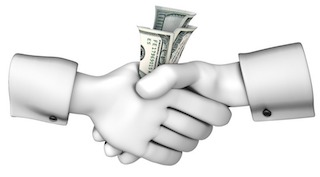Jul 28th, 2015 - Category: Sales
As a result of a recent project (and several recent posts), I have been thinking quite a bit about salesperson compensation. Over the years, I have spent a considerable amount of time with salespeople and have heard the good, bad, and ugly sides of compensation plans. The overall goals are straightforward: reward exceptional performers and weed out below average performers. Most talented salespeople (and sales managers) are more comfortable with ”industry standard” compensation practices. One book that I have used as a reference is Chicelli’s “Compensating the Sales Force.” This author is a more conservative sales compensation consultant with ideas that are in line with the state of the practice. To summarize a long and fairly complex book, the basic philosophy is that the major function of sales is to “persuade buyers in the face of uncertainty and risk.” Therefore, salespeople should be compensated for their ability to “influence the point of persuasion.”
This philosophy has a major effect on compensation plans. For example, if you are selling commodity products into your core markets, these sales typically have the least risk (and profit) so they should be compensated at the lowest level. On the other hand, growth initiatives typically require selling newer products, possibly into new markets, which is more challenging (and more profitable) so these sales should be compensated at progressively higher levels. These compensation goals can be achieved through a combination of techniques such as:
- A higher contribution to quota for riskier products / markets
- Simply increasing overall quotas from year to year to incentivize growth
- With special one-time sales bonuses (SPIF - sales performance incentive fund)
In general, Chicelli’s favorite plan for outside sales engineers is called “3x”. It is a plan where top performers earn 3x the variable compensation component over the lowest performers and there is no cap on maximum compensation. To use real numbers, I took some 2013 percentile levels from this website: http://www.usawage.com/usa/sales_engineers-salary.php
- 90th percentile of pay - $155K
- 75th percentile of pay- $124K
- 50th percentile of pay- $94K
- 25th percentile of pay- $72K
- 10th percentile of pay- $56K
Again, to summarize, Chicelli starts with a 70% base salary / 30% incentive pay plan with a target total cash compensation goal of around the 60th percentile (roughly $100K). If a salesperson does 100% of quota, they make $100K, poor performers make $70K (25th percentile) and top performers earn $160K which again is “3x” the variable compensation part of the plan. This is above the 90th percentile. This sounds complex, but it really isn’t and it still provides flexibility for companies to adjust contribution to quota from various product / market areas and to adjust the breakpoints for each tier of “3x.” A starting point could be 130%, 160%, 190%, 210%, etc. of quota to keep it simple and again, it is uncapped which salespeople tend to prefer psychologically. This also fits with the typical compensation budget estimates in which two thirds of the sales team makes their quotas. In typical years, the third that do not help offset the extra compensation paid to the top performers.
 He also has some good ideas for compensating new hires, one of which is a “step-down guarantee.” This is where new hires also use the 3x plan, but it provides a guarantee that steps down from 75% of their target total cash compensation to 0% guarantee over six months. So in month one, they will definitely make 75% of their target total cash compensation, in month two, 62%, etc. A company could do this over a year if that makes more sense, but the total annual target compensation might be reduced since the risk would be lower.
He also has some good ideas for compensating new hires, one of which is a “step-down guarantee.” This is where new hires also use the 3x plan, but it provides a guarantee that steps down from 75% of their target total cash compensation to 0% guarantee over six months. So in month one, they will definitely make 75% of their target total cash compensation, in month two, 62%, etc. A company could do this over a year if that makes more sense, but the total annual target compensation might be reduced since the risk would be lower.
Finally, a recent post from Chicelli’s blog is also a good, short read: “Moderate Pay Raises Slated for Sales Personnel in 2015 after 2014 Blowout.” Many new and successful salespeople could be at risk of leaving in 2016 due to a combination of the improving economy and the fact that many of them are having a good year this year, making 2016 growth targets seem hopeless. It’s great to have a great year, but the increase in quota due to “quota hangover” the following year can be rough, especially when demand for talented salespeople is back on the rise. In the next post of this series, the opposite side of the compensation equation, how salespeople (when motivated by the right compensation plan) can provide insight into your business that no other source can provide.